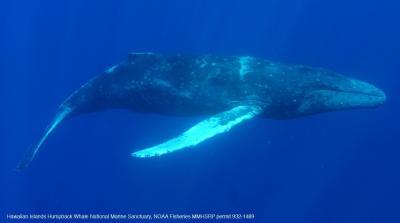Humpback whales share a simplistic skin bacterial community across populations, according to results published March 26, 2014, in the open access journal PLOS ONE by Amy Apprill from the Woods Hole Oceanographic Institution and colleagues. The overall bacterial communities differ by geographic area and by metabolic state, such as feeding versus starving during migration and breeding.
Bacterial communities living on mammal skin may play a role in their health; for humans, there is a relationship between skin bacteria and allergic or inflammatory conditions. While skin bacteria are frequently studied in humans, less is known about the composition of skin bacteria in other mammals. Whales move thousands of miles through the ocean and come in contact with numerous bacteria. Scientists studied the bacterial species on the skin of humpbacks from different geographical areas, as well as their health conditions to better understand the role these microbes play in their health. They genetically sequenced over 500,000 genes from bacteria obtained from humpback whale skin collected in various geographic locations in the Pacific and Atlantic and during various stages of the life cycle, including during breeding and feeding. These data were also compared to bacterial sequences found on the skin of deceased whales and whales with injuries and compromised health from entanglement in fishing line.

A humpback whale breaches off American Samoa, a study site in the South Pacific. One of the sources of samples in this study was skin shed by breaching whales. Image was taken by CCS under NOAA permit 774-1714 and the approval of the Government of American Samoa.
(Photo Credit: Amy Apprill)
The authors found that the general bacterial community of the healthy individuals consisted mainly of Tenacibaculum and Psychrobacter spp., sequences that were specific to humpbacks, but the overall composition of the bacterial populations differed by geographical location and metabolic state, as well as in stressed and deceased individuals. The latter contained less core bacteria (Tenacibaculum and Psychrobacter spp.) and more potential pathogens. These results may indicate, according to the authors, that the bacterial skin community may act as an indicator of whales' health and the status of the environment. Though more work needs to be done, this study may help researchers monitoring the population health and conservation status of threatened or endangered marine mammals.
"It is astonishing that we find Tenacibaculum and Psychrobacter spp. bacteria on whale skin regardless of animal age, sex, metabolic state, geographic region or population. These bacteria may be involved in an important interaction with the whales," Amy Apprill added. "With further development, we might be able to gain insight into the health of whales by examining their skin-bacteria."

A humpback whale displays scars on its skin after being freed of entangled fishing gear, which it trailed during its entire migration from the Bering Sea (off Alaska) to Hawaii. The bacteria residing on skin of this and other entangled or deceased whales were found to contain fewer core members and more potential pathogens than the healthy animals. Image and sample taken courtesy of Edward Lyman, Hawaiian Islands Humpback Whale National Marine Sanctuary and NOAA's Marine Mammal Health and Stranding Response Program, Permit #932-1489.
(Photo Credit: Amy Apprill)
Source: PLOS